More about Thimbles





Magdalena and William Isbister.
My wife and I have been collecting thimbles for about 25 years. In May 1990 I started work in the Kingdom of Saudi Arabia. Because I was working as a surgeon at a referral hospital, my patients came to see me from all over the country. We had seen “Marsh Arab”(1), Afghani (2), and “nomadic” (Turkoman) (2) thimbles in the Thimble Society of London (TSL) magazine but never any thimbles from the Arabian Peninsula. Our sojourn in the Kingdom was to last for 11 years, and during this time we tried to find out about and obtain local thimbles. I thought that my patients, coming from different tribes from all over the Kingdom would be both a good source of intelligence and a good source of thimbles. I was sadly wrong in this assumption, as time was to show.
My first task was to find the Arabic word for thimble. Although Edwin Holmes lists an Arabic word for thimble (4), I found it much more difficult to find the same word in Saudi Arabia. I first asked my trainee surgeons whether they knew the word, and despite drawings and hand gestures, I drew a blank. They just did not know anyone who sewed, except for surgeons, and generally they did not use thimbles. I tried next to ask a few patients with the help of the young surgeons, who acted as interpreters, but they could not really see the relevance of my questions, and despite hand gestures from myself, I again made no progress. One day I was discussing my quest for local thimbles with my clinic nurses, when a very good Palestinian nurse said that she knew the Arabic word for thimble, kustuban. From then on, she became my main translator and communicator in my search for the elusive Saudi thimble. I asked her to tell the patients that I was trying to buy “old” thimbles and that I wanted to know whether they had any “old” thimbles at home.
Over the following months it became apparent that few Saudi women did any sewing and thus did not own thimbles or have any knowledge of thimbles. In the more elegant families, the servants did any sewing needed, and their mistresses knew little of what they did. In the poorest families it seemed that sewing was done without the help of a thimble. In days gone by girls were sewn into their dresses. The sleeves were very tight, and the seams had to be sewn and unpicked when the clothes were changed. In those times slaves probably did the sewing. Again no one seemed to know anything about thimbles. With the exception of the Hijaz (the western region around Jeddah and Mecca), where pilgrims annually entered and left the Peninsula on their way to and from Mecca, there was very little contact between the tribes of the Peninsula and the outside world, until the early to middle part of the last century when Abdulaziz bin Abdulrahman al Saud united the tribes and created the Kingdom of Saudi Arabia. Thus, there was very little western influence in the Peninsula prior to this, and it is unlikely, therefore, that the people were exposed to any western sewing tools.
Bedouin silver jewellery was usually made in Yemen by Yemeni silversmiths, who were often Jews and who signed their works in Arabic. Sometimes such a silversmith travelled in the Peninsula with one of the wandering tribes. We wondered whether they had ever made thimbles. Despite searching in most of the ”antique shops” in the Kingdom (we travelled many miles), we were unable to find anything resembling a thimble. There were rings of all types and sizes, gold with turquoise, gold with glass, and just plain silver but no thimble and nothing like the thimble and ring combinations that may be seen in Turkmenistan.
Towards the end of our time in the Kingdom, a new National Museum opened in Riyadh. The history of the Kingdom was documented in detail. There were pre-Islamic artefacts dating back many thousands of years, and amongst them were some gold and steel needles but not a thimble or anything resembling one. In the more recent collection, which dated back about 70-90 years, we did find several what looked to be thick leather finger covers, which were not described, but which had come from the Eastern Province. They were probably used for sail making. We never found any similar items outside of the museum.
My patient enquiries had fared no better. One kind lady did bring a small packet, which contained some small steel thimbles marked “Taiwan.” I thanked her very much for her kindness but realised that I had failed to explain in my questioning that I was looking for “old” Saudi thimbles. On each subsequent occasion, I stressed the word for old, quadim. This strategy failed to produce any old thimbles either. But, during the years that I was in the Kingdom, I did amass quite a collection of modern West German and Taiwanese thimbles. Saudis, in general, did not seem to be too interested in their history and seemed to feel that “new” things were best; hence they could not understand why I should be looking for “old” thimbles and in kindness brought me the better “new” versions. Maybe they felt that I was asking for “old” thimbles, because they were worthless, and they wanted to bring me a nice “new” gift. Whatever the reason, I was not able to find anyone who would bring me something old.
Each spring at Al Janadriyah, 45 miles east of Riyadh, the National Guard organise a National Folklore and Cultural Fair. Crafts from all over the Kingdom are demonstrated. In a large courtyard building, set out like an old souq (a traditional market place of small shops), the individual artisans can be seen working at their crafts. On one day during the festival, the grounds are opened to “families” (men and women together), and since many westerners seem to attend on this day, the rules governing photography seem to be relaxed a little. It is thus possible to see and photograph people making coffee pots, guns, and baskets and to watch bookbinders and weavers at work. During one of our visits to Al Janadriyah, we saw an old man working with a quilt. He sat cross-legged on the floor and had a dimpled gold ring on his right middle finger, which he used for pushing his needle (Fig 1).

He maintained tension in the material by means of a hook, which was attached to his right great toe by a cotton band (5) (Fig 2).

Fig 2. Needle ring with hook and cotton tension band.
We had not seen anything similar in any other place. But, one day in the clinic, towards the end of my stay, I was surprised when a patient brought me a similar ring (Fig 3) and hook and said that it had belonged to her grandmother. I was very excited and thanked her very much.

Fig 3. Thimble ring.
This was the first, arguably “old” thimble that had been brought to the clinic, and I was very grateful.
I have a picture of an old man sewing with what looks like a white fabric finger protector (6). We never saw another during our stay. As we also collected Bedouin silver and other artefacts during our stay, we did search the antique souqs on a regular basis. We went down to the “Antique souq” in Riyadh on many occasions. On our way we used to pass through other souqs, where men were often seen making leather sandals (without pushers), fur-lined cloaks, and mishlas (the fine wool, black, fawn, and now sometimes cream-coloured gowns worn by important males). Many of the men were sitting cross-legged on the floor sewing, but at no time did we ever see any type of thimble. In the souq, I did find an “old” Bedouin agal, which is a form of head decoration worn by both men and women, which was decorated with some western brass thimbles (Fig 4).
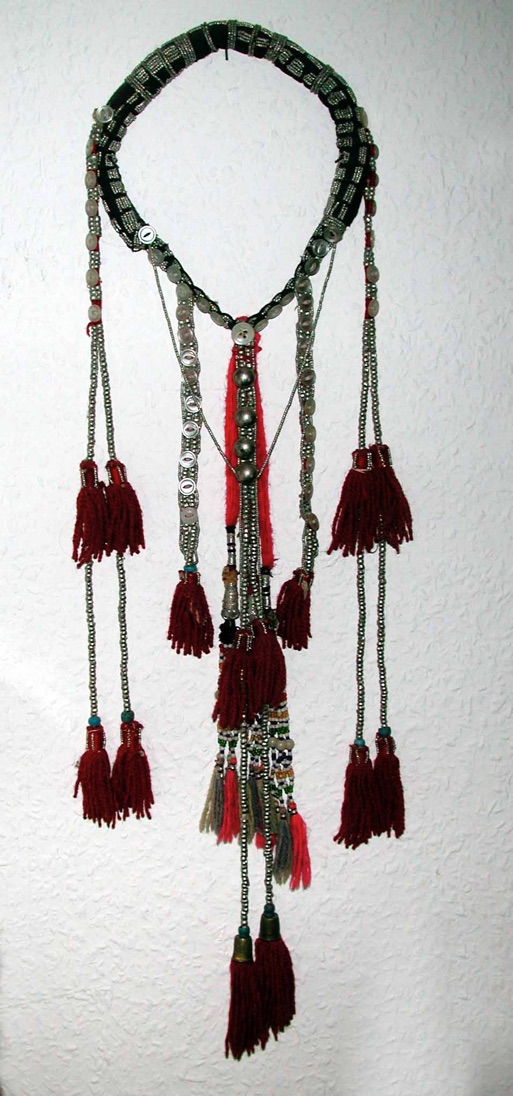
Fig 4. Female agal with two small brass thimbles.
A similar use of thimbles for decoration has been used by Indian tribes in North America.
One day an old Bedouin lady, attending my clinic for follow-up, passed me a parcel wrapped in Kleenex tissues. It contained two old ring-type thimbles, which she said were very old. They were the first signs of any thimble used by the tribes that we had seen and may have dated back about 100 years. I was very pleased that at last an older thimble had been found. The patient was showing her gratitude to me for her surgery, but I was equally pleased to get the thimbles. One of the thimbles may have been a silver decoration from the barrel of an old rifle, although it may even have been used for sewing too (Fig 5).
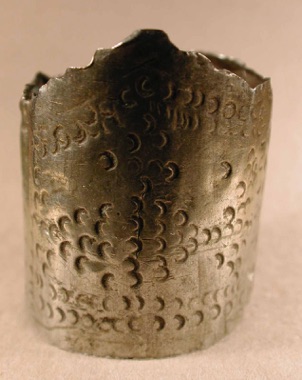
Fig 5. Ring-type thimble.
The other, I think, was, in fact, a ring-type thimble and had been used for sewing by her great-great-grandmother (Fig 6).
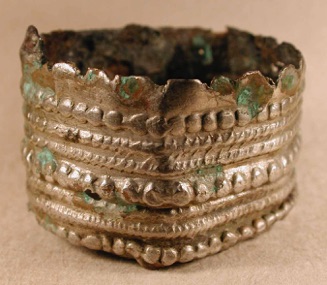
Fig 6. Ring-type thimble, possibly rifle barrel decoration used as thimble.
Throughout our stay in Saudi Arabia, we made regular trips to Dubai, because I was an examiner at the Medical College. Apart from the modern “western type” thimbles, which we saw in souvenir shops, we were not able to find any old thimbles in Dubai either.
What did we learn about thimbles from our experiences in the Kingdom? Firstly, the mistress of the house rarely practises sewing today in Saudi homes. Thus, the mistresses have little knowledge of the tools associated with the art. Secondly, cloth and leather finger protectors were used in relatively recent times and were probably the primary method of finger protection in the past, and, as in other countries where this was happening, few have remained for posterity. Saudis are proud of the present and prefer “new” to “old,” making collection of antiquities difficult. Lastly, ring-type thimbles may have been in use in some tribes, but the silversmiths did not make them in large quantities.
References
1 Thimbles, no. 47, 48. TSL magazine, 7, no. 3 (1999): 7.
2 Thimbles, no. 46, 49. TSL magazine, 5, no. 3 (1994): 14.
3 du Quesne Bird N. TSL magazine, 5, no. 4 (1994): 22.
4 Holmes, Edwin F. A History of Thimbles. London: Cornwall Books, 1985.
5 Isbister WH. TSL magazine, 7, no. 4 (1999): 3.
6 Isbister WH. TSL magazine, 7, no. 4 (1999): 3.
TCI Bulletin Spring 2004
Holmes: na.
Addendum
Since the original paper was written we have managed to acquire several of the thimbles mentioned in the first paragraph of the paper.
Marsh Arab
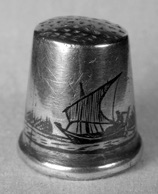
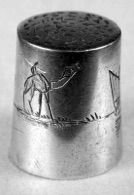
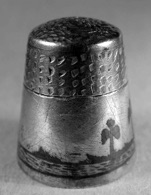
Niello Marsh Arab thimbles from Persia, ca. 1900
Afghan
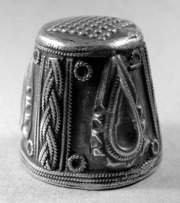
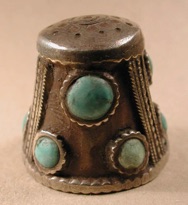
Silver applied filigree thimbles with and without turquoise stones. Afghanistan ca. 1900
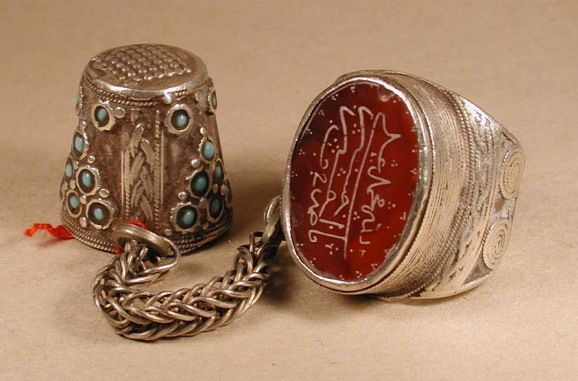
Silver thimble with small turquoise stones attached to ring with carnelian stone engraved in Arabic script 'Allah, Mohammed, Ali (Mohammed's son), Fatima (Ali's wife), Hassan and Hussein (Ali and Fatima's sons)'
Nomadic (Turkoman)
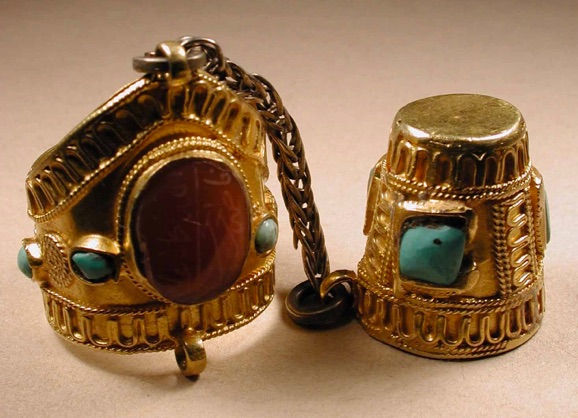
21k gold, applied filigree, thimble and ring, set with turquoise and carnelian stones, and joined by a silver chain. Probably part of a wedding decoration. Turkmenistan ca. 1900
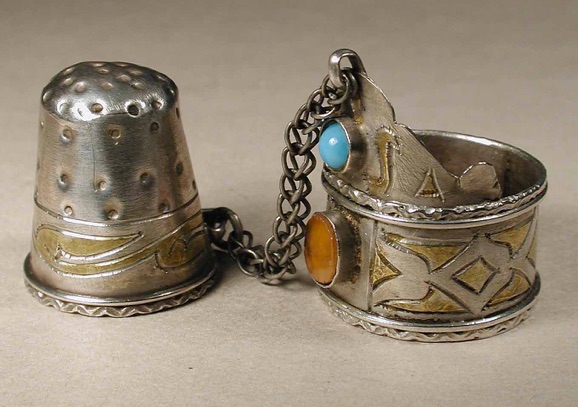
Engraved silver thimble with gilded design attached, by a silver chain, to a silver and gilded, crown shaped, ring with inset carnelian and turquoise stones. Turkmenistan ca. 1900
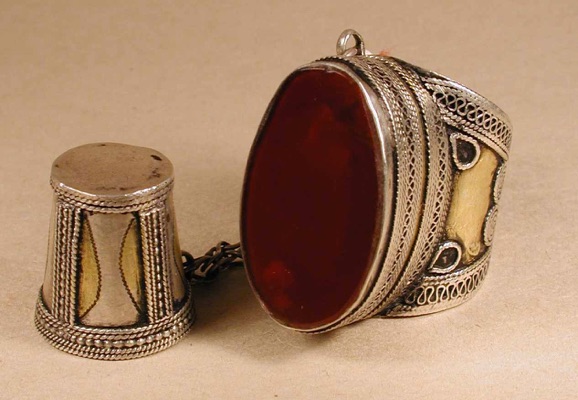
Silver thimble with applied filigree border with gilded patterns, applied filigree rim. Thimble attached to ring with silver chain. Silver filigree and gilded ring with 2.8 cm. carnelian stone. Turkmenistan ca. 1900
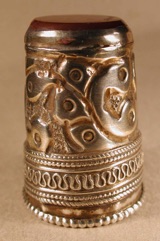
Embossed silver thimble with applied filigree border and applied beaded rim. The thimble has a carnelian stone top. Turkmenistan ca. 1900
Researched and published in 2002/11
Copyright@2011. All Rights Reserved
Magdalena and William Isbister, Moosbach, Germany
collecting thimbles in the kingdom of Saudi arabia
Navigation
